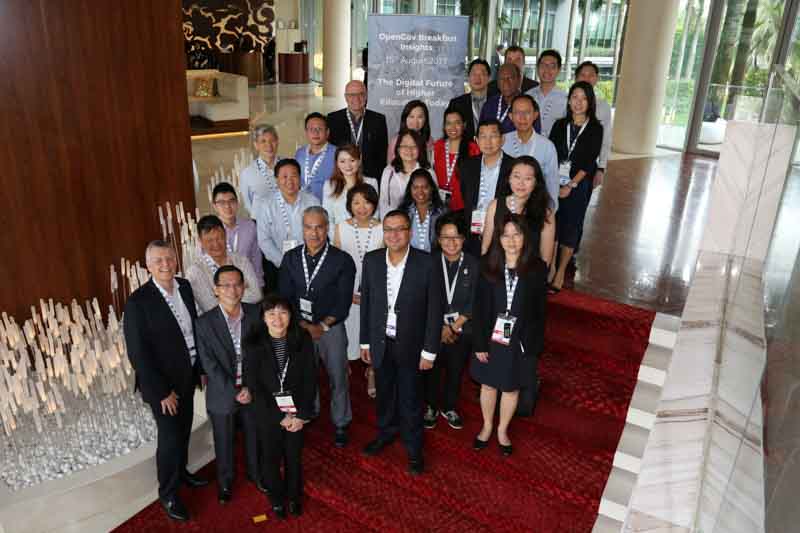
More than 30 delegates from various institutes of higher learning in Singapore came together for roundtable discussion on the topic of the future of digital education. Organised by OpenGov in partnership with SAP, Mr. Mohit Sagar, Managing Director and Editor In Chief of OpenGov Asia began the session explaining the 2 drivers of education- delivering quality education and attracting and retaining student, faculty and staff.

Invited speaker Dr. Ashish Bharadwaj (above), CIO, Laureate Education India, shared about the context of education in India- the country has the 2nd largest education system in the world with 34 million enrollments, 800 universities, 39000 colleges and 12000 standalone institutions. He spoke about 4 government-led initiatives within India impacting and growing the education industry:
- Digital India – an umbrella set of government initiatives for digitalisation in various forms in the government, at both federal and state levels
- Made in India – a goal of creating 100 million jobs in 6 years
- Skill India – which aims to train over 400 million people in India with different skills by 2022
- GST Bill – it seeks to convert India into a single national market with uniform tax structures and it will be expected to boost GDP by 1-2% yearly
Dr. Bharadwaj explained the exponential growth of technology and the emergence of Industry 4.0 in which areas such as big data analytics and advanced algorithms, IoT platforms, smart sensors and multi-level customer interaction/profiling would have inevitably have an impact on education.
Polling questions and discussion
A series of polling questions centred on the use of analytics in the education context were posed to the audience. An overwhelming 65% of the delegates indicated that the employment rate/employability index of their respective institutions’ graduates as the most important success metric for their institutions. Mr. Andy David, Industry Principle, Higher Education, SEA, SAP gave a contrasting example in which the most important success metric for education institutes in the USA was actually student enrollment and retention.
Improving analytical insights

40.9% of the delegates felt that they would be most interested in focusing to improve predictive analytics. However, Prof. Pey Kin Leong (above photo), Associate Provost, Education, Singapore University of Technology and Design (SUTD) explained that student analytics was the most important for him as learning and feedback analytics which is done swiftly with students within the classroom context can help improve the overall student learning experience. Adding on to Prof. Pey’s point, Mr. Henry Tan, Senior Director Planning and Development, Singapore Polytechnic, gave his school’s example of students doing better if they intentionally chose the subjects they wanted to take and in that case, the increase of discretionary admission to certain subjects based on the students’ interests can lead to better learning outcomes. At the same time, tweaking the intervention process after monitoring the students’ progression and getting their feedback can also improve learning outcomes.
Expressing the same concern for her students, Associate Professor Tan Swee Liang (below photo), Director, Centre for Teaching Excellence, Singapore Management University (SMU), said that it was important to be able to analyse the learning experience of students and understand their thinking.

The biggest challenge when looking to adopt new analytical solutions
A common sentiment expressed by the delegates was reducing data silos as many departments or sections within the same education institution may embark on projects which may overlap or often result in the duplication of processes. Another common pain point was engaging the organisation to get their buy-in of the new analytical solutions. Mr. Tan of Singapore Polytechnic suggested that having an institutional approach when it comes to adopting new analytical solutions and looking at the value chain within the school/institution.
The most important KPI for institutions
Unsurprisingly, 66.7% of the delegates indicated that student success was the most important KPI for their respective institutions, which resonated with the earlier response of the employment rate/employability index of graduates as the most important success metric of their institutions, often reflected in the findings of annual graduate employment surveys and starting salaries of graduates.
For smaller and newer education institutions, the very real and practical concern of recruiting new students was the most important KPI for them, as expressed by Ms. Karen Ong, Head of Media & Communications, Management Development Institute of Singapore (MDIS) and Prof. Pey of SUTD.
The most important success metric for student engagement
A majority of 78% of the delegates felt that the ability to have 2-way interaction was the most important success metric for student engagement. Although the success metric of the speed of deploying information for students was at 0%, Mr. Alfred Low, Head Education Technology, Office of Academic Affairs, Nanyang Academy of Fine Arts (NAFA), explained that while interactions with students were good, it was also important to find out if students fully understood or agree with the questions that were asked. He preferred disseminating information to students fast.
Ms. Lim Lai Cheng, Executive Director SMU Academy, SMU, saw the ability to interact via different media such as websites, Facebook, email and messaging as the most important success metric for student engagement, as she found that students wanted more unofficial platforms of learning such as getting on social platforms.
The most important success metric in implementing a student system
Improved learning outcomes for students had the highest percentage of votes at 56%, which was consistent with the above-mentioned discussion points. Ms. Tay Chor Ngo, Registrar, NAFA, felt that student systems can definitely leveraged on further and do more for the students.
Security of student systems
The topic of security was raised by some of the delegates, especially when increased numbers of IoT-enabled devices are introduced into the school environment, posing a security risk. Another aspect that is traditionally not looked into is the security of student systems and it will have to be addressed in designing and implementing of future systems.
















